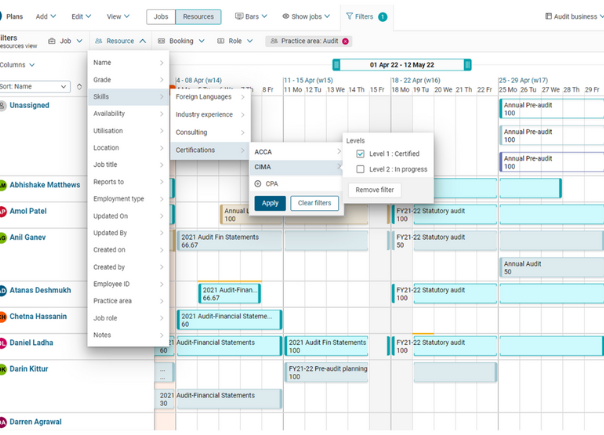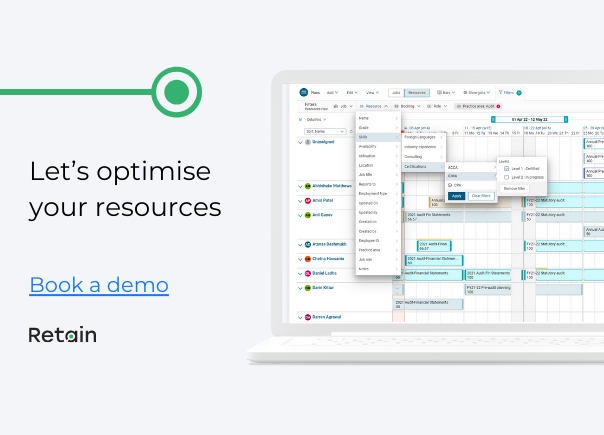Given the explosion of AI in resource management, discussions about improving resource scheduling are becoming top of mind. However, most organisations are still scheduling resources manually. Slowly. Expensively. Inconsistently. Insecurely.
That simply doesn’t need to happen anymore. The resource planning market is evolving constantly. There’s no shortage of ways to help teams become more modern, effective, and efficient.
Yes, even if you don’t have the budget for some hefty ERP solution. Or there’s no time or energy to re-evaluate your tech-stack. Specialist resource scheduling software like Retain prove their ROI and integrate across your existing tech, so you get more from your current investments.
In this guide, we’ll explore both the WHY and the HOW of improving resource scheduling. So you can assess whether your organisation needs to take a leap forward, fast.
The need for change in resource scheduling
In the unpredictable world of resource planning, sticking to manual resource scheduling is going to make things harder for you every day. Sure, it’s what you know, but is it practical?
Here are the top three reasons why change isn't just necessary; but urgent.
Manual resource scheduling challenges
Manual scheduling is slow, frustrating, and prone to errors, and let's face it—it's a relic of a bygone era. The cost isn't just in hours spent; it's in opportunities missed.
The impact on business
Inconsistencies in scheduling lead to a domino effect: missed deadlines, underutilised resources, and overworked teams. It's not just about the financial hit; it's about the stress and strain on your most valuable asset—your people.
The evolving resource planning software market
Now, the good news. The resource planning market is full of innovation. With Retain at the forefront, gone are the days of grappling with clunky spreadsheets and whiteboards. The future? It's digital, integrated, and, most importantly, it's here now.
Key takeaway: In unpredictable people-based businesses, manual resource scheduling is a major drawback. It's slow, error-prone, and costly in terms of missed opportunities and business impacts. Inconsistencies in scheduling can lead to missed deadlines, strained teams, and significant stress on your workforce.
So let’s look at why and how you can improve resource scheduling.
Why improve resource scheduling
You might think, "If it isn’t broken, don't fix it." But here's the twist: it is broken, and it desperately needs fixing.
As we’ve briefly touched on, poor resource scheduling can cause a domino effect impacting everything from time, scope, cost, risk, quality, and of course your resources themselves. Without a clear grasp of resource scheduling—it's tough to make solid plans. And that hurts efficiency and morale all around.
Let's take department managers as an example.
When they lack good visibility into resources like staff skills or project budgets, they end up flying blind. Suddenly they're scrambling to pull teams together or asking for people to put in overtime, just to meet deadlines. It turns into a mad dash, and no one has clarity on priorities.
The ripple effects are big too.
You wind up with people with the wrong skill sets trying to problem solve together when their skills don't meet client needs. Employees feel drained from putting out fires, instead of hitting strategic goals. And money flies out the window paying overtime and last-minute contractor support.
The fix lies in optimising resource scheduling. This gives project and resource managers the foundation to allocate resources strategically and set their teams up for success.
People have clarity on expectations, projects run smarter, and the business stays lean and mean.? (More on this next.)
5 essential strategies for optimising resource scheduling
When done right, resource scheduling can transform your project management. But what does best practice resource scheduling look like?
Here are a few tips to optimise the scheduling of resources:
1. Allocate with breathing room: Don't allocate more than 80% of an employee's time to scheduled tasks. The remaining 20% is crucial for flexibility, unexpected tasks, and essential admin work. Overbooking leads to burnout and dropped tasks. A 100% booked schedule is a red flag. (You can read more about best practice resource utilisation here.)
2. Match tasks with skills and experience: Resource scheduling isn't just about who is available; it's about the right fit. Consider the skills, experience, and cost of each resource. Sometimes investing in high-skill resources is necessary for specific project objectives, while other times, more cost-effective resources can suffice. A strategic balance here is key for cost-effectiveness and project success.
3. Plan for multiple scenarios: Projects are rarely straightforward. Develop multiple 'what-if' scenarios to prepare for unexpected changes or challenges. This foresight in resource management helps navigate unforeseen circumstances, keeping your project on track. Explore this further in our guide to resource forecasting.
4. Strategic project prioritisation: When resources are tight, prioritise projects that bring the most value. Identify activities that contribute significantly to your organisation's goals, focusing more on these 'high-impact' tasks. This approach helps maximise outcomes with limited resources.
5. Implement resource placeholders: When certain resources are undecided or unavailable, use placeholders in your scheduling software. This strategy helps you map out demand for specific roles and skills, allowing you to adjust your plan as resources become available or decisions are made.
6. Optimise resource utilisation and reduce costs: Resource scheduling systems are invaluable for optimising employee allocation from lower to higher priority projects, enhancing profitability and even sustainability. These tools also assist in monitoring critical financial aspects of projects, such as profit margins, revenue, and resource costs, facilitating proactive management and cost control.
7. Maximise limited resources: By coordinating with other departments, project managers can make the most of available resources, completing more tasks without incurring the costs of additional hires.
8. Anticipate and mitigate resource risks: When external factors can greatly impact project timelines, predicting and managing resource risk is more crucial than ever. Drafting resource risk plans, based on the resource schedule, is key. These plans consider the resources needed for on-time project completion and potential jeopardies, such as competing projects or supply chain issues. They also explore alternative resource sources in case primary ones become unavailable.
Stepping up your scheduling game creates benefits that ripple across your entire business. Think; reduced overheads, maximised resource utilisation, and a team that's more in sync. It's about working smarter, not harder.
So, you have the strategies to follow, but how do you implement them? This is where modern resource scheduling solutions step in.
How to modernise resource scheduling
In today's unpredictable working world, modernising resource scheduling is crucial for staying competitive and efficient. It's about leveraging technology and innovative practices to transform your scheduling from a mundane task into a strategic advantage. Here’s how you can do it:
Adopt advanced resource scheduling software
Modern resource scheduling software, like Retain, can automate mundane tasks while providing real-time visibility into your schedule. Automated scheduling reduces manual effort and errors, and real-time updates mean you can make adjustments on the fly.
Top tip: An intuitive user interface also smoothens team adoption when moving from Excel to new technology.
Resource planning tools, like Retain, are built with the challenges of resource management in mind. They offer features that will save you time on resource management tasks while surfacing the data and insights that you need to see.

Seamless integration with existing systems
It’s really important that your chosen scheduling software can integrate with your current platforms like project management or HR systems. Smooth data synchronisation across systems maintains consistency and prevents duplicate work. The right integration allows you to leverage the strengths of different platforms.
Utilise data analytics for strategic planning
Look beyond day-to-day scheduling by utilising data analytics for strategic planning. Identifying trends in resource usage can uncover inefficiencies. Predictive analytics takes this a step further by forecasting future resource needs, allowing you to avoid bottlenecks. Analytics transforms basic scheduling data into an asset for continual improvement.
Enhance team collaboration
Shared resource plans with access control features promote transparency and coordination across teams while ensuring access is granted to the right individuals. At-a-glance visibility into cross-departmental workloads also enables better collaboration.
Feedback loop for continuous improvement
AI-powered resource scheduling software creates a feedback loop for continuous improvement. Machine learning algorithms continually learn and refine resource allocation strategies and suggestions over time. As a result you can get smarter at optimising your unique resource management requirements.
As an interesting side note, a shift in work culture goes hand-in-hand with modernised scheduling practices. Clear communication and change leadership helps the transition. An agile mindset understands schedules must flex alongside shifting team availabilities and project timelines. With strong adoption, your organisation as a whole becomes more dynamic.
Need proof? Let's talk real-life transformations.
Modern resource scheduling in action

Consider world-leading provider of audit, tax, and consulting services, RSM Cayman, where expansion triggered a critical need for an efficient resource allocation system. As the firm outgrew its Excel-based system, challenges emerged, including sluggish file management, restricted multi-user access, and version control issues.
“Although these challenges weren't debilitating, they impeded the firm's ability to maintain real-time data and promptly address resourcing needs to fulfil client requirements.”
A switch to modern scheduling? The result was RSM Cayman saw substantial improvements in operations. The availability of allocation schedules to all employees was expanded, leading to enhanced planning of engagements and timelines.
The most notable change was the ability to access "live" data, reducing the need for static documents. This change saved the team up to 16 hours of administration per week, combined.
This streamlined resource allocation not only saved time but also allowed for more efficient use of employee time and availability.
The transition to Retain brought about a more streamlined process for collaborating and allocating resources, enabling better resource utilisation. The firm can now provide its clients with more focused attention due to reduced administrative tasks.
What you’ll need in modern resource scheduling software
As illustrated by RSM Cayman, tools like Retain aren't just about filling slots; they're about optimising every aspect of your scheduling. Plus, they're user-friendly, highly efficient, and they play well with your existing tech.
Here’s a quick overview of some of the key aspects you’ll want your resource scheduling solution to do:
Advanced features for comprehensive scheduling
✅Dynamic scheduling: Access features that adapt to changing project needs and employee availability in real-time.
✅Resource optimisation: Employ algorithms that help in optimal allocation of resources, ensuring the right person is assigned to the right task.
User-friendly and intuitive design
✅Ease of use: Choose software with an intuitive interface, making it accessible for all team members regardless of their tech-savviness.
✅Customisable dashboards: Ensure the tool provides customisable dashboards for a personalised view of schedules, tasks, and projects.
Integration with existing technology
✅Seamless integration: Focus on tools like Retain that integrate smoothly with your current technology stack, enhancing rather than disrupting your existing workflows.
✅Data syncing: Look for software that allows for easy syncing of data across different platforms, ensuring consistency and accuracy.
Efficiency and productivity enhancement
✅Automated processes: Automate routine scheduling tasks to save time and reduce manual errors.
✅Data-driven decisions: Use the software’s analytics to make informed decisions about resource allocation and project timelines.
Supporting remote and hybrid work
✅Cloud-based resource scheduling: Opt for cloud-based scheduling tools that support remote and hybrid work environments, allowing team members to access and update schedules from anywhere.
✅Collaboration features: Ensure the software facilitates collaboration, such as sharing schedules, setting up meetings, or assigning tasks.
Scalability for future growth
✅Adaptability: Select software that can scale as your business grows, capable of handling increased demand and complexity.
✅Continuous updates: Choose providers who offer regular updates, keeping the software current with the latest trends and features.
Side note: Retain offers all of this and more. You can take a look at an overview of our cloud-based resource planning software here. Or book a demo for a personalised tour.

Optimise resource scheduling with the right software
So, we've looked at the whys and hows of sprucing up your resource scheduling. It's clear that clinging to old methods is like refusing to swap a typewriter for a laptop. (Inefficient, to say the least.)
Remember, upgrading to resource planning software is about keeping your business agile, your teams harmonious, and your operations slick.
Now, it's over to you. Take a hard look at your current scheduling system. Does it feel like it's from the 1980’s? If yes, it's time for a change.



